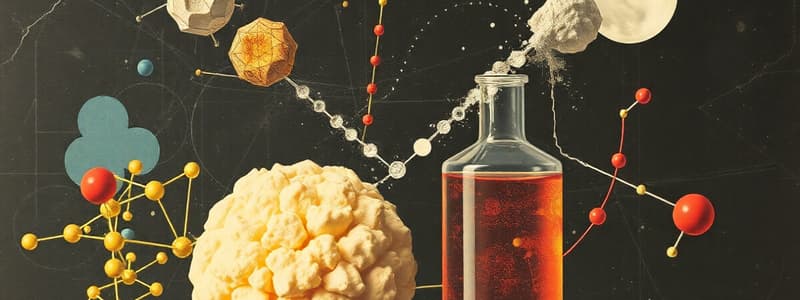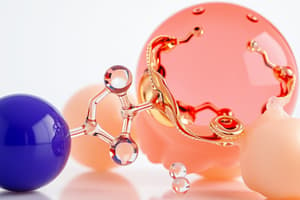Podcast
Questions and Answers
Which of the following is NOT a characteristic of solids?
Which of the following is NOT a characteristic of solids?
- Cannot flow
- High density
- Definite shape and volume
- Easily compressible (correct)
Liquids can diffuse faster than gases because their particles are larger.
Liquids can diffuse faster than gases because their particles are larger.
False (B)
What is the main reason that solids have a definite shape and volume?
What is the main reason that solids have a definite shape and volume?
The strong intermolecular forces between the particles hold them in relatively fixed positions, resulting in a rigid structure.
The intermolecular forces between molecules are called ______ forces, while the forces within a molecule are called ______ forces.
The intermolecular forces between molecules are called ______ forces, while the forces within a molecule are called ______ forces.
Which of these are considered van der Waals forces?
Which of these are considered van der Waals forces?
The strength of an ion-dipole interaction increases as the charge of the ion decreases.
The strength of an ion-dipole interaction increases as the charge of the ion decreases.
What is the term used to describe the tendency of an atom to attract electrons?
What is the term used to describe the tendency of an atom to attract electrons?
London dispersion forces are the only intermolecular forces present in ______ molecules.
London dispersion forces are the only intermolecular forces present in ______ molecules.
Match the following intermolecular forces with their respective descriptions:
Match the following intermolecular forces with their respective descriptions:
Hydrogen bonds are stronger than dipole-dipole forces.
Hydrogen bonds are stronger than dipole-dipole forces.
Explain the difference between a covalent bond and a hydrogen bond.
Explain the difference between a covalent bond and a hydrogen bond.
Which of the following molecules will exhibit hydrogen bonding?
Which of the following molecules will exhibit hydrogen bonding?
Which property explains why liquids cannot expand to fill a container?
Which property explains why liquids cannot expand to fill a container?
Liquids diffuse more quickly than gases.
Liquids diffuse more quickly than gases.
What is the term for the phase change from liquid to gas?
What is the term for the phase change from liquid to gas?
The degree of attractive forces between neighboring particles in liquids is referred to as __________.
The degree of attractive forces between neighboring particles in liquids is referred to as __________.
Match the properties of liquids with their descriptions:
Match the properties of liquids with their descriptions:
Why are liquids said to be slightly compressible?
Why are liquids said to be slightly compressible?
Liquids maintain a fixed shape regardless of the container they are in.
Liquids maintain a fixed shape regardless of the container they are in.
Why are solids generally denser than liquids?
Why are solids generally denser than liquids?
What will happen to the volume of a solid when it is heated?
What will happen to the volume of a solid when it is heated?
Solids can flow and take the shape of their container.
Solids can flow and take the shape of their container.
What is the main reason that liquids are harder to compress compared to gases?
What is the main reason that liquids are harder to compress compared to gases?
The intermolecular forces of attraction between solid particles are ______ than those in liquids.
The intermolecular forces of attraction between solid particles are ______ than those in liquids.
Which of the following statements is true regarding liquids?
Which of the following statements is true regarding liquids?
Match each characteristic to either solids or liquids:
Match each characteristic to either solids or liquids:
Liquids diffuse faster than solids due to faster moving particles.
Liquids diffuse faster than solids due to faster moving particles.
Can a liquid boil without an increase in temperature? If yes, explain how.
Can a liquid boil without an increase in temperature? If yes, explain how.
Flashcards
Kinetic Molecular Theory
Kinetic Molecular Theory
Explains states of matter based on tiny particles in motion.
Intermolecular Forces
Intermolecular Forces
Attractive forces between neighboring particles that affect states of matter.
Kinetic Energy
Kinetic Energy
The energy of an object due to its motion, affecting particle movement.
Definite Volume
Definite Volume
Signup and view all the flashcards
Fluidity
Fluidity
Signup and view all the flashcards
Density in Liquids
Density in Liquids
Signup and view all the flashcards
Ability to Diffuse
Ability to Diffuse
Signup and view all the flashcards
Vaporization
Vaporization
Signup and view all the flashcards
Properties of Solids
Properties of Solids
Signup and view all the flashcards
Kinetic Molecular Model of Solids
Kinetic Molecular Model of Solids
Signup and view all the flashcards
Diffusion of Liquids vs. Gases
Diffusion of Liquids vs. Gases
Signup and view all the flashcards
Boiling Without Temperature Increase
Boiling Without Temperature Increase
Signup and view all the flashcards
Characteristics of Incompressibility
Characteristics of Incompressibility
Signup and view all the flashcards
Density of Solids
Density of Solids
Signup and view all the flashcards
Liquid Flow
Liquid Flow
Signup and view all the flashcards
Van der Waals Forces
Van der Waals Forces
Signup and view all the flashcards
Dipole
Dipole
Signup and view all the flashcards
Electronegativity
Electronegativity
Signup and view all the flashcards
Hydrogen Bond
Hydrogen Bond
Signup and view all the flashcards
Ion-Dipole Forces
Ion-Dipole Forces
Signup and view all the flashcards
London Dispersion Forces
London Dispersion Forces
Signup and view all the flashcards
Polar Molecules
Polar Molecules
Signup and view all the flashcards
Instantaneous Dipole
Instantaneous Dipole
Signup and view all the flashcards
Study Notes
Kinetic Molecular Model of Solids and Liquids
- The kinetic molecular theory explains the states of matter. It posits that matter is composed of tiny particles that are always in motion. This theory explains properties and behaviors of solids, liquids, and gases.
- The kinetic molecular model explains the properties of solids and liquids in terms of intermolecular forces of attraction and the kinetic energy of individual particles.
Intermolecular Forces
- Intermolecular forces are attractive forces between neighboring particles of one or more substances. They pull particles together.
Kinetic Energy
- Kinetic energy is the energy that comes from motion. It keeps particles at a distance, moving around. Kinetic energy depends on the temperature of the substance.
Kinetic Molecular Model - Perspective
- A few drops of blue food coloring added to water will spread throughout the water, eventually coloring it. This happens because the particles of water and food coloring are constantly moving due to their kinetic energy.
Kinetic Molecular Model of the Liquid State
- This model explains how liquids behave.
Liquid Properties
- Definite Volume: Fixed volume, does not vary. Liquids cannot expand to fill a container.
- Fluidity: Liquids can flow and adjust to the shape of their containers because their molecules are free to move.
- Density: The molecules of a liquid are relatively close together, making liquids denser than gases.
- Slightly Compressible: Liquids are much less compressible than gases because their particles are closer together.
- Dissolving Ability: Liquids can dissolve solids, liquids, and gases.
- Ability to Diffuse: Liquids diffuse more slowly than gases due to the constant motion of particles.
- Tendency to Evaporate and Boil: Vaporization is the liquid to gas phase change. Evaporation and boiling are the two classifications of vaporization.
- Tendency to Solidify: Freezing is the liquid to solid phase change.
Questions on Liquids
- Why are liquids denser than gases? Molecules are closer together, resulting in more molecules in a given area.
- Why are liquids harder to compress than gases? Molecules are closer together.
- Why do liquids diffuse slower than gases? Molecules are not moving as fast.
- Can a liquid boil without increasing the temperature? Yes, by lowering the atmospheric pressure.
Kinetic Molecular Model of the Solid State
- This model explains how solids behave.
Solid Properties
- Definite Shape and Volume: Solids maintain a definite shape and volume, regardless of the container. This is due to tightly packed particles.
- Non-fluid: Solid particles cannot flow because they are held in relatively fixed positions.
- High Density: Solids are packed more closely than liquids or gases.
- Incompressible: Solid particles are packed so tightly together that there is virtually no space between them.
- Intermolecular Force: Intermolecular forces between particles in solids are stronger than in liquids or gases. This keeps the solid rigid.
Intermolecular Forces of Attraction
- Intermolecular forces (IMF) of attraction are the forces between molecules. These include dipole-dipole, hydrogen bonding, ion-dipole, and London dispersion forces.
- These forces are weaker than covalent bonds that occur within a molecule.
Dipole-Dipole Forces
- Dipole-dipole forces exist between polar molecules.
- Polar molecules have unequal electron densities which creates a dipole (partial positive and partial negative ends).
- Polar molecules attract each other when unlike charges are close together and repel when like charges are close together.
Hydrogen Bonds
- Hydrogen bonds are special dipole-dipole interactions.
- They occur in molecules that contain hydrogen bonded to a small, highly electronegative atom (e.g., N, O, F).
- The electronegative atom attracts electrons toward itself, creating partial negative charges. The hydrogen then acquires a partial positive charge, which strongly attracts the partial negative charge of a neighboring electronegative atom.
- Unlike covalent bonds, hydrogen bonds do not involve sharing of electrons. They are intermolecular forces.
Ion-Dipole Forces
- Ion-dipole forces occur between an ion and a polar molecule.
- The degree of ion-dipole interaction depends on the size and charge of the ion. Cations interact more strongly than anions with dipoles.
- Cations (positive ions) interact more strongly with dipoles.
London Dispersion Forces
- London dispersion forces are intermolecular forces that exist between all atoms and molecules.
- They are the weakest of the intermolecular forces.
- They occur due to temporary variations in electron distribution within a molecule, creating temporary dipoles.
- The size of a molecule affects the London dispersion force between two molecules. Larger molecules have greater London dispersion forces.
Studying That Suits You
Use AI to generate personalized quizzes and flashcards to suit your learning preferences.




